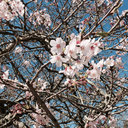Oenothein B inhibits the expression of PbFKS1 transcript and induces morphological changes in Paracoccidioides brasiliensis.
Słowa kluczowe
Abstrakcyjny
The fungus Paracoccidioides brasiliensis is the causative agent of paracoccidioidomycosis (PCM), the most prevalent human systemic mycosis in Latin America. Drug toxicity and the appearance of resistant strains have created the need to search for new therapeutic approaches. Plants with reputed antimicrobial properties represent a rich screening source of potential antifungal compounds. In this work, the growth of P. brasiliensis yeast cells was evaluated in the presence of oenothein B extracted from Eugenia uniflora. The oenothein B dosage that most effectively inhibited the development (74%) of P. brasiliensis yeast cells in vitro was 500 microg/ml. To verify if oenothein B interferes with cell morphology, we observed oenothein B-treated yeast cells by electron microscopy. The micrographs showed characteristic cell changes noted with glucan synthesis inhibition, including squashing, rough surface, cell wall rupture and cell membrane recess. The expression of P. brasiliensis genes was evaluated in order to investigate the action of oenothein B. Here we report that oenothein B inhibits 1,3-beta-glucan synthase (PbFKS1) transcript accumulation. The results indicate that oenothein B interferes with the cell morphology of P. brasiliensis, probably by inhibiting the transcription of 1,3-beta-glucan synthase gene, which is involved in the cell wall synthesis.



